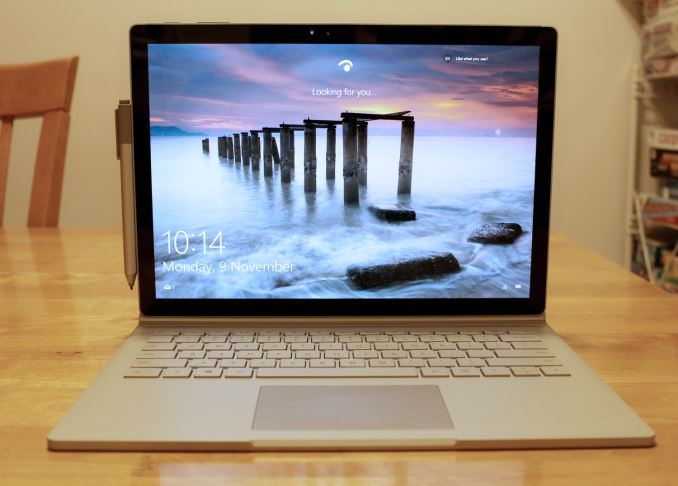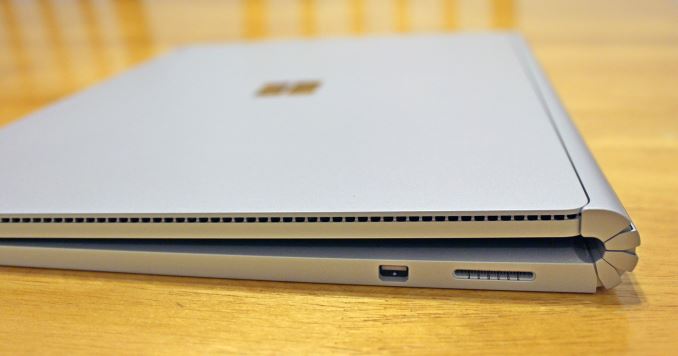The Microsoft Surface Book Review
by Brett Howse on November 10, 2015 8:00 AM EST
When Microsoft first launched the Surface Pro, they decided to tackle a market that was pretty much untested. Sure, tablets had been around for a while already, but no one had packed a full Ultrabook inside of a tablet. True, the initial Surface Pro had some compromises made due to the hardware available at the time, but Microsoft started to build a brand with Surface, a brand that they lifted from another product line altogether. It’s taken a few generations for the hardware to catch up with that original vision, but I think it’s fair to say that the Surface Pro tablet line has solidified itself as the Windows tablet to beat. The build quality, materials, and performance, are really second to none at this time.
I’m talking about branding because it’s one of the most difficult parts of a new product lineup. Microsoft, perhaps more than most companies, has certainly had its struggles with branding over the years. Surface though, has truly been defined, and molded, and evolved, into a strong brand for the company, and it plays right at the high end. And that brings us to Surface Book. Surface Book is an extension of the Surface brand, and Microsoft now wants to try its hands at the laptop market. Their goals for Surface Book are certainly not the same as they were for the original Surface Pro, since the laptop market is already well defined, and there are already many excellent devices available. For Microsoft to throw their hat in the ring in this segment is a much different proposition than before, and to succeed, as well as to continue to evolve the Surface brand, they set out to build what they are calling “The Ultimate Laptop”.
Surface Book certainly keeps the tradition of Surface alive and well. The 13.5-inch laptop has the same 3:2 aspect ratio of the rest of the Surface line, and it is built out of magnesium with the same finish. The fit and finish is very high, and the entire device feels as premium as it should. I think the defining feature of the Surface tablet lineup is the kickstand, and with the Surface Book it is most certainly the hinge. The hinge on the Surface Book is truly unlike anything ever used on a notebook computer before, and while it may not be to everyone’s taste, it certainly draws comments. The hinge, other than a design element, brings a lot of function to the party as well, with it being a key component to keeping this laptop balanced correctly. Balance is generally not an issue with laptops, but the Surface Book has another trick up its sleeve – the display detaches. The Surface Book is hardly the first device to do this, but it is one of the few that has tried to tackle the balance problem with 2-in-1 devices where the screen detaches, and the hinge is a key component to that. Microsoft calls it a Dynamic Fulcrum Hinge, and it extends the base of the laptop slightly to give it more leverage over the display section.
The design is unique, and what is inside is unique as well, at least potentially. There are two models of the Surface Book. The first model is a typical Ultrabook inside, with an Intel Core i5-6300U processor, but the second model is the only detachable laptop which also has a discrete GPU. There are a couple of reasons this has never been done before, with the main reason being it’s very difficult to dissipate the extra heat that a GPU brings to the table. Microsoft has designed the Surface Book with a GPU which lives in the keyboard base, with the rest of the required components behind the display. This gives them two thermal zones, and by moving the GPU to the base like this, it lets the Surface Book cool the CPU and GPU independently. The extra space in the keyboard is then packed with batteries.
| Surface Book | |||
| Core i5 | Core i5 w/GPU | Core i7 w/GPU | |
| GPU | Intel HD 520 | Intel + "NVIDIA GeForce" (Approx. GT 940M) w/1GB GDDR5 |
|
| CPU | 6th Generation Intel Core i5-6300U (15w) | 6th Generation Intel Core i7-6600U (15w) | |
| Memory | 8-16GB RAM | ||
| Display | 13.5" IPS 3000x2000 resolution 1800:1 Contrast Ratio 100% sRGB, individually calibrated 10 point touch and Pen support |
||
| Storage | PCIe 3.0 SSD 128 GB to 1 TB | ||
| I/O | USB 3.0 x 2 (In Base) SD Card reader (In Base) Surface Connector (In Tablet and Base) Headset Jack Mini DisplayPort |
||
| Dimensions | Laptop (mm) : 232 x 312 x 13.0-22.8 (inches) : 9.14 x 12.3 x 0.51-0.90 Tablet Only (mm) : 220.2 x 312.3 x 7.7 (inches) : 8.67 x 12.3 x 0.30 |
||
| Weight | Laptop 1.515 kg / 3.34 lbs Tablet Only 726 g / 1.6 lbs |
Laptop 1.579 kg / 3.48 lbs Tablet Only 726 g / 1.6 lbs |
|
| Camera | Windows Hello (Front) 8 MP Rear Facing 5 MP Front Facing |
||
| Price | $1499+ | $1899+ | $2099+ |
Looking at the specifications, one thing to point out is the battery capacity. Most Ultrabooks would average somewhere around 50 Wh of capacity, with a few somewhat higher and a few somewhat lower. By combining the battery in the tablet, which Microsoft calls the Clipboard, with the base, the Surface Book has an amazing 70 Wh of battery capacity. This should help out on battery life, assuming the 3000x2000 display doesn’t drag that down. The rest of the Surface Book is pretty similar to the Surface Pro 4, with PCIe NVMe storage options up to 1 TB, and touch and pen support via the PixelSense display. There are also two USB 3.0 ports in the base, along with a DisplayPort output, and the Surface Connect port which is used for charging, as well as connecting the Surface Dock. There are no ports on the Clipboard at all, with the exception of the Surface Connect port, so if you are using the Clipboard on its own, you will have to dock it to access USB. Like the Surface Pro 4, it would have been nice to see a USB Type-C port included, and the Clipboard would be a perfect spot for that.
Microsoft is calling the Surface Book “The Ultimate Laptop” and that is a pretty lofty goal for a first generation product. In this review, we will examine all aspects of the Surface Book and see how they compare to the best laptops around. Let’s start with the design.











249 Comments
View All Comments
EzioAs - Tuesday, November 10, 2015 - link
Not for PC.Teknobug - Tuesday, November 10, 2015 - link
It's Xbox One exclusive for a year.cwolf78 - Tuesday, November 10, 2015 - link
Actually it's coming to Windows 10 in March I believe. PS4 version is not coming out until "Holiday 2016"close - Tuesday, November 10, 2015 - link
How is this MS's response to the iPad Pro? That's just an oversized tablet. This is a convertible which had 3 generations of similar products behind it. If anything, the iPad Pro is Apple response to all the ultraslim devices sporting a larger diagonal out there. Like the Surface...darwinosx - Tuesday, November 10, 2015 - link
Apple isn't interested in making something is both a mediocre laptop and tablet. They prefer to make an outstanding table and laptop and thats my preference when buying.pixelpusher - Tuesday, November 10, 2015 - link
I use both mac and windows for a living. I would just suggest one overlooked feature of the surface book by reviewers is that the thermals are directed away from your lap, which makes it lapable in a way previously unexperienced even on a macbook, in that it does not require one sacrifice his offspring to use it for prolonged periods of time atop your pelvis when laying on a couch or bed. Moving the intel part to the middle of the tablet where fingers do not typically grip, plus away from the bottom which comes in contact with your thighs or pelvis area is a move that is most welcome. So there is something in this design that is IMO better than normal laptops (Apple or otherwise).sprockkets - Tuesday, November 10, 2015 - link
In case you don't know, you are replying to an apple troll. I suggest you ignore it, unless you want your iq to drop in half.ninjacut - Tuesday, November 10, 2015 - link
yes! I was so used to heated lap from all earlier laptops the Surface Book changes the experience.Gigaplex - Tuesday, November 10, 2015 - link
That really depends on whether you get a dGPU variant, which can pump out a bit of heat on its own.xthetenth - Tuesday, November 10, 2015 - link
If you prefer an outstanding tablet, why would you buy an oversized phone?Modern tablets that have learned from the past few years of development running a proper OS for the full capabilities of the tablet form factor offer a great deal more. Stylus support alone is a huge addition that brings a huge number of potential use cases, shipping without an adjustable stand is a travesty, and limiting a tablet to a task switching and app opening UI that's obsolescent even on the phones it's lifted from is beyond farce.
On the plus side, Apple does seem to have paid some attention, and is making their first attempt at a full-featured tablet. Pity that it seems three years in the past regarding such incredibly basic things as how to design a tablet stand, and the stylus doesn't place the same functionality in the user's hand.
At least they're trying, rather than still making supercharged relics of bygone concepts of user interaction that get by on ecosystem inertia.
Their laptops are pretty nice, and definitely top tier though if you want just a laptop although I prefer the priorities of the XPS series. Pity that you can't get decent tablet capabilities and full functionality without having to drag both devices and totally giving up any advantage in weight. My surface is nice and light and I never have to worry about whether I should take another device because I might have to do something it literally cannot do.
Have a great day and don't get scoliosis from dragging around two devices and a pad of paper to do the job of one!